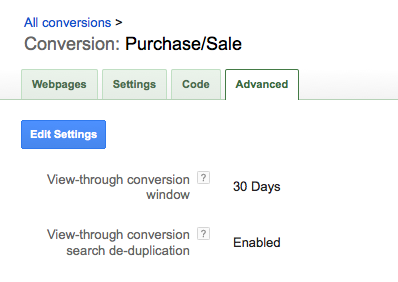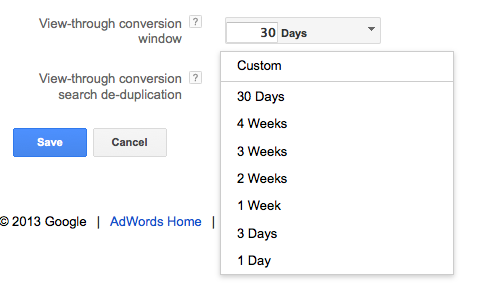View-through conversions have been around for nearly four years in AdWords. In paid search land, that’s close to an eternity. But it still seems to me that people don’t really know what to do about them. We’ve talked about them and their slippery attribution in the past, and today I’d like to spend even more time diving into VTCs and how they should affect the ways in which we manage our accounts on a day-to-day basis.
As a refresher, View-through conversions are only counted for image or display ads. If you are only running text ads on the display network, you won’t see any figures coming in for VTCs, but if you’re running any image ads and you’re also tracking conversions in your account, these babies are already being measured.
A View-through conversion “measures the number of conversions that occurred within 30 days of your display ad appearing for which there was no ad click generated.” This definition comes from the original announcement of VTCs all those years ago, and in the meantime advertisers have been given some options to allow them to customize their tracking.
Under Tools & Analysis > Conversions > (Click on a specific conversion that you’re tracking) > Advanced you’ll be given the below options:
Straight from AdWords – “This ‘window’ is the number of days after an ad is viewed during which a conversion will be counted.” What’s pretty cool is that you are afforded the opportunity to change how long this window is. It’s customizable and you can update it however you see fit.
Unlike Facebook’s post-impression conversion tracking, though, you won’t have any visibility into when within that window your VTCs are coming in. If something occurs within your window it counts as a VTC and you won’t be able to break it down by one day post impression, one week post impression, etc.
View-through conversion search de-duplication is another interesting setting (which makes this page two for two on interesting settings). The default option is Disabled, so if you haven’t ever really futzed around with VTCs before your settings will all be on Disabled. This option is intended to give you more clarity about how much value your image ads are adding.
Disabling de-duplication gets us into double negative land, and as any bad grammarian couldn’t tell you, that can be pretty confusing (do you see what I did there?). Here’s my attempt at a plain English explanation of de-duplication:
If View-through conversions are not de-duplicated (the standard setting), someone who sees a display ad of yours and then later converts by clicking a branded ad will trigger two conversions for you – one VTC for your display campaign and another conversion for your branded campaign.
If, however, you have decided to de-duplicate (meaning that setting is Enabled), when someone sees a display ad of yours and then later converts by clicking a branded ad you will only see one conversion – the regular conversion in your branded campaign. There will be no VTC reported.
The natural question that flows out of this is then:
Should you de-duplicate your View-through conversions?
I spent a while wondering about this myself, so I picked one of my accounts and gave it a whirl. Here are the stats for my remarketing campaign (the only display this advertiser is running) for the thirty days before and after updating this option:


This test was definitely on the smaller side. And one month was clearly better than the other one (as 4 conversions is infinity % higher than 0 conversions), but there wasn’t a drastic difference in View-through conversions. Over a similar time frame the number of VTCs was similar. Nothing crazy happened, which I think is a good thing. I was also only testing on a remarketing campaign, which I’ve seen elsewhere has a higher incidence of VTCs. It makes sense, as people who came to your site before are definitely more inclined than your average bear to come back and convert all by themselves. What role my display ads played in bringing back to the site continues to be a bit hard to say.
I used to be of the opinion that everyone should enable de-duplication because it led to cleaner data – you don’t want to double count those conversions, even if they are very different conversion types. But as I’ve changed the ways in which I use VTCs I think I’ve come around on leaving de-duplication off. If someone converts via clicking on a search ad later, you still want to know if an ad could have possibly nudged a user to click (even if it was subliminal).
I personally use VTCs in two ways. The first is helping decide a winner in image ad testing. I’ll still rely on the primary metrics I focus on during ad testing (CTR, Conversion Rate and Conversions/Thousand Impressions {which abbreviates to the delightful to pronounce conv./mImp}). But if the primary stuff is too close to call, I’ll take a look at VTCs to get a sense of what’s having more of an impact. In almost all cases VTCs line up with the better metrics overall, so it’s just a good way to confirm what you were already thinking.
You can also add VTCs to your placement reports to see what sites are driving a lot of View-throughs for you. If you want to build out a managed placement campaign, I think looking to your high VTC sites is a good place to start (along with your high regular conversion sites).
So if you’re trying to decide whether or not to enable de-duplication, think about how you plan on using VTCs. As a tie breaker/double check on ad tests or a farm for managed placements, I don’t have any qualms counting them twice. If you are a serious stickler about attribution and the avoidance of double counting, you should probably get to enablin’.
What Value Do VTCs Really Add?
This is definitely hard to measure under normal circumstances. We had a reader share a very helpful link with us about a test that he ran with VTCs. Through running a blank ad at the same time as a real display ad, he measured the VTCs for each creative and measured the actual lift of the image ad. He found a 20% lift on the actual creative, which isn’t too shabby in my opinion. This is the only direct case study I’ve seen of such an experiment, but it was a pretty cool one to me.
Do you guys have any interesting strategies with VTCs to share? Any strong opinions one way or the other about de-duplication? I’m definitely glad to have this conversion type tracked, but I’m still trying to figure out if there’s anything more concrete to do with them aside from help decide ad tests and find great managed placements. Let us know how you feel!





